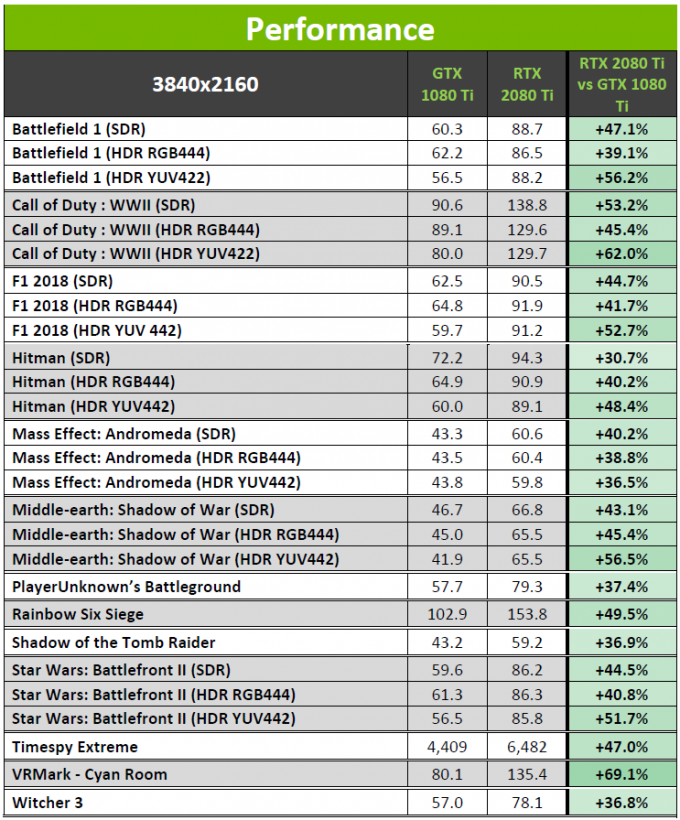- Qualcomm Launches Snapdragon 4 Gen 2 Mobile Platform
- AMD Launches Ryzen PRO 7000 Series Mobile & Desktop Platform
- Intel Launches Sleek Single-Slot Arc Pro A60 Workstation Graphics Card
- NVIDIA Announces Latest Ada Lovelace Additions: GeForce RTX 4060 Ti & RTX 4060
- Maxon Redshift With AMD Radeon GPU Rendering Support Now Available
NVIDIA GeForce RTX 2080 & 2080 Ti 4K & Ultrawide Gaming Performance

NVIDIA’s new Turing-based GeForce RTX graphics cards have landed, and we have a lot of performance information inside these few pages to help you justify (or not justify) a purchase. We’re pitting both of the new cards along with six last-gen models against eight games at three resolutions – including 4K and 3440×1440.
Page 5 – Final Thoughts
NVIDIA made some big promises at its GeForce RTX launch event last month, and at least as far as RTX Off performance is concerned, those promises seem to be proven true. Across the eight games I selected for testing, the average gain at 4K for the RTX 2080 Ti over the GTX 1080 Ti was 36% – with the peak at 47%, and floor at 27%.
That’s all fine and good, but of course, the biggest beef people have with this launch is the price. NVIDIA can try to justify it any way it wants, but the fact of the matter is, last generation’s Ti cost $649, and this generation’s costs $999, the same as Pascal’s TITAN Xp. We know another TITAN is en route, because there’s still room left on the 2080 Ti’s chip for more cores. The day of the $999 TITAN seems to be gone.
If the only thing that matters to you is gaming performance, and you don’t mind splurging on a new top-end graphics solution, you’re going to see considerable gains with the 2080 Ti over 1080 Ti – 36% on average at 4K, as mentioned before. That’s suitable for those willing to splurge, but what about those who’ve gotten into the routine of paying less (or even the same) for more?
I’ve said many times on our pages over the years that one of the best things about technology is that it continually gets better, and continually gets cheaper. Yet with this launch, NVIDIA has reversed the trend, where people will effectively pay the same as before for the same level of performance. Or perhaps even less, since in some cases, the $649 1080 Ti outperformed the $699 RTX 2080, which doesn’t have a model available for less than $789.99 as of the time of writing. For comparison’s sake, some 1080 Tis can still be found at the $649 price point.
I’m guessing the reason NVIDIA is charging a premium here is because of the Tensor and RT Cores, and I can’t exactly argue against it. R&D and processor manufacturing costs money, and while the processors can’t be used to great effect right now, I do believe ray tracing will play a big role in our gaming future. It’s nice to see ground being broken to pave the way for large scale adoption.
Beyond future possibilities, the Tensors could also be used for some workstation work, like AI denoising, so NVIDIA might be charging a bit more than usual to get more dough out of workstation users who plan to ignore the $2,000+ Quadros and could deal with a $699 or $999 GeForce just fine instead.
Ultimately, NVIDIA’s unlikely to care right now about pricing angst, because the cards are selling well. I’ve talked to friends before the launch who preordered multiple cards even before the performance reports were out. When that initial surge calms down, who knows what will happen. It’s just unfortunate right now that the cheapest Turing solution available is $649 – it leaves a massive part of NVIDIA’s anxious fan base waiting for other wallet-friendly options that might not even outperform their current gear.
A quick note about performance: In the reviewer’s guide for GeForce RTX, NVIDIA highlights performance differences in games between using them in SDR and HDR modes. With Battlefield 1, for example, a 47% improvement could be seen in HDR, but the same test would increase to 56% in HDR YUV422. An even bigger gain could be seen in Hitman, bouncing from 31 to 48%.
Unfortunately, I don’t have an HDR monitor here, so I can’t test this out for myself yet, but it’s something I hope to tackle in the near future. One thing to be aware of is that HDR generally will mean better performance on RTX, but not always, and NVIDIA will admit that. In the same document, Mass Effect: Andromeda showed a reduction when moving to HDR (but not enough to cause you to want to disable the feature you bought your monitor for).
General performance expectations based on Techgage testing can be seen in this table:
Game Performance Expectations |
|||||
| 1080p | 1440p | 3440×1440 | 4K | 144Hz | |
| RTX 2080 Ti | ★★★★★ | ★★★★★ | ★★★★ | ★★★★ | ★★★★ |
| RTX 2080 | ★★★★★ | ★★★★★ | ★★★★ | ★★★ | ★★★★ |
| TITAN Xp | ★★★★★ | ★★★★★ | ★★★★ | ★★★ | ★★★★ |
| GTX 1080 Ti | ★★★★★ | ★★★★★ | ★★★★ | ★★★ | ★★★★ |
| GTX 1080 | ★★★★★ | ★★★★ | ★★★ | ★★ | ★★★ |
| RX Vega 64 | ★★★★★ | ★★★★ | ★★★ | ★★ | ★★★ |
| GTX 1070 Ti | ★★★★ | ★★★ | ★★ | ★ | ★★ |
| RX Vega 56 | ★★★★ | ★★★ | ★★ | ★ | ★★ |
| GTX 1070 | ★★★★ | ★★★ | ★★ | ★ | ★ |
| RX 580 | ★★★ | ★★ | ★ | ★ | ★ |
| GTX 1060 | ★★★ | ★★ | ★ | ★ | ★ |
| RX 570 | ★★★ | ★★ | ★ | ★ | ★ |
| GTX 1050 Ti | ★★ | ★ | ★ | ★ | ★ |
| RX 560 | ★★ | ★ | ★ | ★ | ★ |
| GTX 1050 | ★ | ★ | ★ | ★ | ★ |
| RX 550 | ★ | ★ | ★ | ★ | ★ |
| 144Hz values based on 1080p resolution with high detail goals. ★★★★★ 60 FPS? More like 100 FPS. As future-proofed as it can get. ★★★★ Surpass 60 FPS at high quality settings with ease. ★★★ Hit 60 FPS with high quality settings. ★★ Nothing too impressive; it gets the job done (60 FPS will require tweaking). ★ Not recommended. |
|||||
The GeForce RTX 2080 Ti becomes the first GPU to be separated from the others in 4K gaming. It becomes as ultimate a 4K GPU as we’ve ever had, delivering well over 60 FPS at high graphics detail across most games. For 144Hz gaming at 1080p, lesser expensive options could be opted for.
Ultimately, NVIDIA’s 2080 Ti is a great GPU. It brings great new features along with substantial performance improvements. 2080 Ti to 1080 Ti, the gains averaged to 36% at 4K, which is exactly the kind of bump we like to see from major new launches (even 25% is less exciting). According to NVIDIA, the gains can be even higher in cases where HDR is used, but at the same time, a 47% boost was seen in my testing, so those gains will definitely fluctuate a bit from title to title.
It’s impossible to conclude on this card right now based on what we have available. The card offers support for features that can’t be fully taken advantage of yet, like ray tracing and other RTX enhancements (outside of specific DLSS benchmarks). In a couple of months, it’s going to become a lot clearer what GeForce RTX is capable of. It’s not often we see a launch that’s almost ahead of its time, but that’s the case here. Windows itself needs to be updated to support Microsoft DXR, so when that and the game updates become available, I’ll dive back in and give RTX a thorough hands-on test.
For now, if money isn’t a big concern, but performance is, NVIDIA continues to wear the performance crown with its Turing GeForce. The 2080 Ti really is a technologically impressive graphics card, and will serve high-end gamers very well.
The 2080 Ti is a proper update following what seemed like a very long drought, and it’s one with a lot of cool features coming. If none of those features seem to matter a great deal to you right now, the upside is this: last-gen cards can still be found, and as the 1080 Ti results have shown, that GPU can still deliver great 144Hz and 4K experiences in comparison to the new cards.
Whoever does adopt NVIDIA’s new Turing GeForces are going to have an amazing time, especially in the future – even if their wallet won’t.
Support our efforts! With ad revenue at an all-time low for written websites, we're relying more than ever on reader support to help us continue putting so much effort into this type of content. You can support us by becoming a Patron, or by using our Amazon shopping affiliate links listed through our articles. Thanks for your support!








